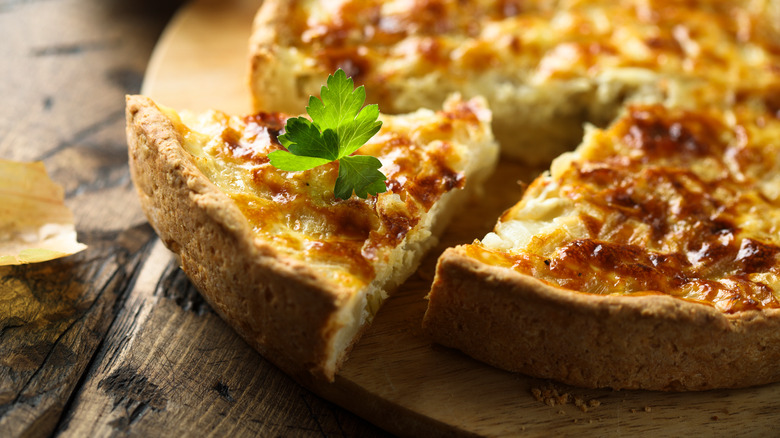The Real Reason Your Quiche Is Soggy
If you've ever tucked into a still-warm slice of eggy, buttery quiche, then you know how delicious this brunch staple can be. Much like a savory version of pie, quiche is simply an egg custard that's poured into a pastry crust, often layered with other ingredients such as shredded cheese, sliced vegetables, or pieces of meat or fish, and baked in a hot oven until just tender on the inside, with a crispy, flaky crust.
Typically thought of as a French dish, there's compelling evidence that quiche actually originated in medieval Germany, in the southwest kingdom of Lothrigen, which was later annexed by France and renamed Lorraine (via Importico's Bakery Cafe). There, the iconic smoked bacon and egg quiche Lorraine is said to have taken its early form, with the word "quiche" coming from the German word "kuchen" for cake.
Whatever type of quiche you like to make — whether it's Lorraine or springy leek and spinach or your own invention — you may have been plagued, in the past, by a soggy end result, with both the filling and the crust coming out too waterlogged. A sodden quiche really takes away from the dish's tastiness, so we're going to explain why it happens (and how to avoid it next time).
Wet fillings will produce a soggy quiche
We've all — hopefully — enjoyed a picture-perfect quiche in our lives, one that's characterized by a burnished, flaky crust and a flavorful, tender egg filling. But all too often, quiches seem to turn out wet and watery, with moisture dominating not only the filling but also seeping into the crust below and turning it mushy. According to Real Simple, this typically occurs when adding too-wet ingredients to the quiche filling, layering the egg custard with, for example, large slices of raw tomato or raw zucchini. These vegetables, while tasty, have a high water content when raw, which will weep into the quiche as it bakes.
Instead of using raw vegetables in quiche, the outlet recommends roasting or sautéing vegetables with a high moisture content before adding them to quiche: That way, they'll release the majority of their water before landing in the egg custard and reducing the chances that it will become soggy. In addition, the flavors in the vegetables will concentrate as they cook, so they'll make a bigger impact in the finished quiche.
If you've sautéed spinach to add to your quiche, The Kitchn recommends squeezing it out before layering it into your savory pie as additional moisture insurance. With these tips, your next quiche will boast a perfect balance of flavor and texture.

